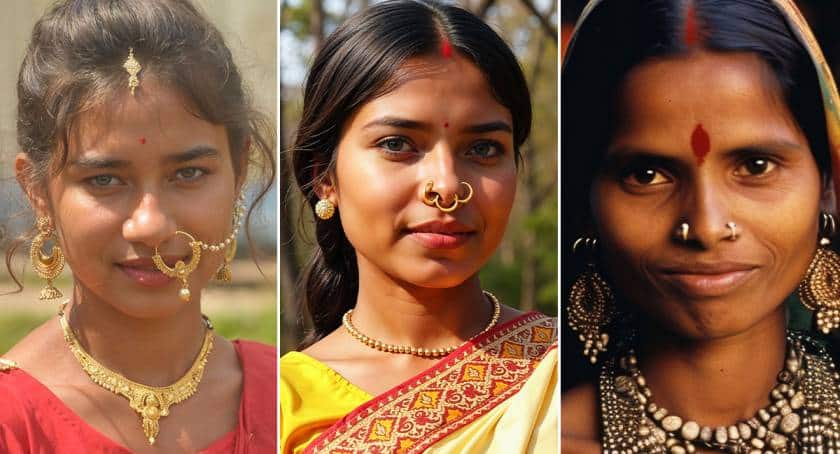Understanding the Cultural Significance of Gold Nose Rings in Odisha
Gold nose rings hold a profound cultural and traditional significance in Odisha, India. These complex ornaments are not just pieces of jewelry but symbols of heritage, marital status, social identity, and spirituality. Passed down through generations, gold nose rings represent Odisha’s rich craftsmanship and cultural ethos. This blog showcases the historical roots, symbolic meanings, and evolving trends of gold nose rings in Odisha’s culture.
Historical Roots of Gold Nose Rings in Odisha
The tradition of wearing nose rings in Odisha dates back centuries. Ancient sculptures, temple carvings, and classical Odia literature depict women adorned with nose rings, highlighting their historical prominence. The influence of temple culture, tribal traditions, and royal heritage has played a pivotal role in shaping the designs and significance of these ornaments.
In ancient times, women from royal families and affluent communities wore nose rings to mark their social status. The grandeur and intricacy of their jewelry distinguished them from ordinary folk. However, this tradition spread across different social classes, becoming integral to Odisha’s cultural identity. Today, gold nose rings are cherished ornaments worn by women across diverse backgrounds, symbolizing beauty and deep-rooted traditions.
Symbolic Significance of Gold Nose Rings in Odisha
- Marital Status and Womanhood: People traditionally associate gold nose rings with marriage in Odisha. Brides wear them to symbolize their transition from maidenhood to marriage, signifying prosperity, commitment, and the blessings of marital bliss. Married women, especially in rural Odisha, continue to wear nose rings as a testament to their marital bond. People believe a nose ring enhances a woman’s beauty and brings good fortune to her married life.
- Auspiciousness and Spirituality: Gold, considered a pure and divine metal, is associated with wealth, prosperity, and positive energy in Hindu beliefs. People believe that gold nose rings shield the user from bad energy and provide good fortune. Many Odia women believe their gold nose rings are a charm for attracting positive vibrations and ensuring happiness.
- Tribal and Regional Identity: Different communities in Odisha have distinct nose ring styles that reflect their unique cultural identity. Tribal women, for instance, wear elaborately designed nose rings that symbolize their lineage, marital status, and social standing. These nose rings’ shape, size, and embellishments vary across different regions, highlighting the rich diversity within Odia culture. Tribal communities in areas like Mayurbhanj and Keonjhar are mainly known for their distinctive nose ring designs.
- Health Benefits According to Ayurveda: Ayurvedic principles suggest that piercing the left nostril, a common practice in Odisha, helps regulate menstrual cycles and eases childbirth. This belief has contributed to the continued practice of nose piercing among Odia women. According to Ayurveda, the left nostril is linked to the female reproductive system, and people believe that piercing enhances overall well-being.
Types of Gold Nose Rings in Odisha
- Phuli: One of Odisha’s most popular nose ring designs, the Phuli is a small gold stud, often adorned with intricate filigree work or gemstones. Married women and young girls alike commonly wear it. The Phuli showcases delicate and elegant craftsmanship, making it a versatile accessory for daily wear and special occasions.
- Nath: The Nath is a larger nose ring, usually worn by brides during wedding ceremonies. Some designs feature chains connecting the nose ring to the earring, adding to the elegance of the bridal attire. The Nath often features intricate designs with pearls, gemstones, or delicate patterns, making it a significant piece of bridal jewelry.
- Mookuthi: This is a nose pin variation popular among Odia women. It is more subtle compared to the Nath but retains a traditional charm. Women who prefer a minimalist yet culturally significant ornament often choose the Mookuthi.
- Tribal Nose Rings: Tribal communities in Odisha have distinct nose ring styles, often more prominent and elaborate than urban designs. These nose rings are typically handmade and feature intricate motifs inspired by nature and tribal symbols. They are bold, eye-catching, and deeply culturally significant among indigenous communities.
Artistry in Odia Nose Rings
Odisha’s skilled artisans create exceptional gold jewelry, including intricately designed nose rings. Skilled artisans use age-old techniques such as filigree and granulation to create beautiful designs. Cuttack’s delicate Tarakasi (silver filigree) work inspires gold jewelry designs, including nose rings. These artisans blend tradition with innovation, ensuring that the artistry of nose rings remains timeless.
Rituals and Occasions Associated with Gold Nose Rings
- Weddings and Engagements: Gold nose rings are an essential part of bridal jewelry in Odia weddings. Brides often receive intricately designed nose rings as part of their wedding trousseau. The Nath, in particular, is a key element of bridal adornment, enhancing the beauty and grace of the bride.
- Religious Festivals and Celebrations: During festivals such as Durga Puja, Raja Parba, and Makar Sankranti, women in Odisha adorn themselves with gold jewelry, including nose rings, to honor traditions and seek blessings. Wearing a nose ring during these celebrations is considered auspicious, signifying devotion and reverence.
- Coming-of-Age Ceremonies: In some Odia communities, young girls receive their first nose ring as part of a coming-of-age ritual, marking their transition into womanhood. Elders often bless during this ceremony, symbolizing growth, beauty, and prosperity.
Final Thoughts
Gold nose rings in Odisha are more than just decorative ornaments; they are symbols of heritage, identity, and tradition. From ancient times to the present day, these beautiful jewelry pieces continue to hold immense cultural significance. While modern adaptations have introduced new designs, the essence of wearing gold nose rings remains deeply rooted in Odia traditions.
Gold nose rings in Odisha have long marked marital status, reflected tribal identity, and expressed personal style—and people will continue to cherish them for generations. Their significance extends beyond aesthetics, embodying history, spirituality, and the artistic brilliance of Odisha’s skilled artisans. Preserving and passing down traditions keeps the beauty and cultural depth of gold nose rings integral to Odia heritage.


